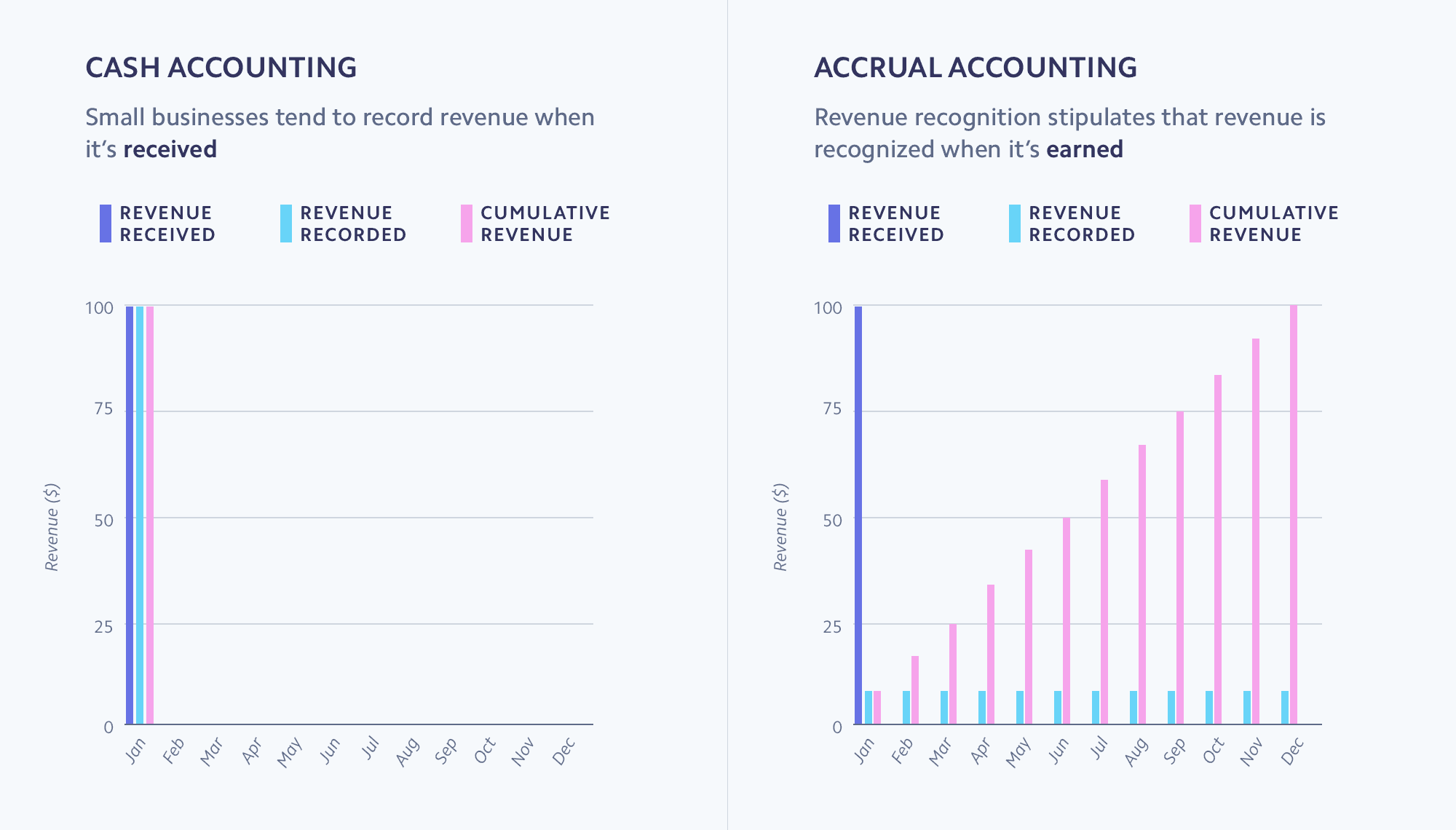รายรับเป็นปัจจัยหลักที่บ่งชี้ถึงแนวโน้มการเติบโตของธุรกิจ ในส่วนของนักลงทุน ธนาคาร และผู้นำภายในองค์กร รายรับคือข้อมูลที่สำคัญยิ่ง ซึ่งแสดงสถานภาพในปัจจุบันและแนวโน้มในอนาคตของบริษัท หากคุณรับรู้และบันทึกรายรับตามแนวทางปฏิบัติที่ดีที่สุด ธุรกิจของคุณก็จะมีแนวโน้มมากขึ้นที่จะแข่งขันและประสบความสำเร็จในตลาดได้
คู่มือนี้มีไว้สำหรับผู้นำธุรกิจที่อยากจะเข้าใจวิธีปฏิบัติตามหลักการและกฎระเบียบด้านการทำบัญชีทั่วโลกไปพร้อมๆ กับการขยายบริษัท แนวทางปฏิบัติด้านการรับรู้รายรับเหล่านี้มักเป็นเรื่องจำเป็นสำหรับธุรกิจที่ตั้งใจจะระดมทุนหรือตั้งเป้าที่จะขอเงินกู้ นอกจากนี้ยังเป็นสิ่งสำคัญสำหรับธุรกิจทุกแห่งที่อยากจะตัดสินใจทางธุรกิจอย่างมีชั้นเชิงโดยใช้ข้อมูลเชิงลึกเกี่ยวกับรายรับที่ถูกต้องอีกด้วย
คุณจะได้เห็นข้อแตกต่างระหว่างการทำบัญชีแบบเกณฑ์เงินสดกับแบบเกณฑ์คงค้าง กฎระเบียบและแนวทางสำหรับการรับรู้รายรับ รวมถึงวิธีดำเนินขั้นตอนนั้นๆ ตามโมเดลธุรกิจของคุณโดยเฉพาะ นอกจากนี้ เรายังจะพาไปดูว่าเครื่องมือการรับรู้รายรับในตัวของ Stripe จะช่วยคุณยกระดับและปรับแนวทางการทำบัญชีให้เป็นไปโดยอัตโนมัติได้อย่างไร
ข้อกำหนดทั่วไปเกี่ยวกับการรับรู้รายรับ
- แนวทางการทำบัญชี:
ธุรกิจขนาดเล็ก: กรมสรรพากรของสหรัฐอเมริกา (IRS) ระบุว่า ธุรกิจขนาดเล็กคือบริษัทที่มีรายรับขั้นต้นต่อปีโดยเฉลี่ยต่ำกว่า 25 ล้านดอลลาร์สหรัฐในช่วง 3 ปีก่อนปีภาษีปัจจุบัน
การทำบัญชีแบบเกณฑ์เงินสด: วิธีการทำบัญชีที่บันทึกรายรับและรายจ่ายเมื่อมีการแลกเปลี่ยนเงินสด ธุรกิจขนาดเล็กที่ไม่มีสินค้าคงคลังมักจะใช้วิธีนี้
การทำบัญชีแบบเกณฑ์คงค้าง: วิธีการทำบัญชีที่คำนวณรายรับและรายจ่ายเมื่อเกิดขึ้นหรือเรียกเก็บเงินแล้ว ไม่ใช่ตอนที่ได้รับการชำระเงิน
หลักการลงบันทึกให้ตรงกัน: แนวทางในการลงบันทึกรายจ่ายให้ตรงรอบกับรายรับที่เกี่ยวข้องกัน แนวคิดในการทำบัญชีแบบนี้จะช่วยให้เห็นผลการดำเนินงานของบริษัทได้ถูกต้องขึ้น และเป็นลักษณะเฉพาะตัวอย่างหนึ่งของการทำบัญชีแบบเกณฑ์คงค้าง (ดูที่ด้านบน)
หลักการรับรู้รายรับ: หลักการทำบัญชีซึ่งเป็นที่ยอมรับกันโดยทั่วไป (Generally Accepted Accounting Principle หรือ GAAP) ที่กำหนดว่า ธุรกิจจะ "รับรู้" หรือบันทึกรายรับในบัญชีของตนเมื่อใดและอย่างไร
- การปฏิบัติตามข้อกำหนดระหว่างประเทศ:
คณะกรรมการมาตรฐานการทำบัญชีระหว่างประเทศ (International Accounting Standards Board หรือ IASB): คณะกรรมการผู้เชี่ยวชาญอิสระที่วางมาตรฐานการทำบัญชีสำหรับบริษัทมหาชนใน 144 ประเทศ โดยแนะนำขั้นตอนต่างๆ ที่ใช้ในแทบทุกประเทศ แม้ว่าบางประเทศ เช่น สหรัฐอเมริกา อินเดีย และจีน จะไม่จำเป็นต้องปฏิบัติตามขั้นตอนเหล่านั้นก็ตาม
มาตรฐานการรายงานทางการเงินระหว่างประเทศ (International Financial Reporting Standard หรือ IFRS): ชุดมาตรฐานและหลักการที่พัฒนาโดย IASB เพื่อให้เกิดความสอดคล้องกันระหว่างตลาด เศรษฐกิจ อุตสาหกรรม และธุรกิจต่างๆ โดยมีความเฉพาะเจาะจงน้อยกว่ามาตรฐานที่เทียบเท่ากันของสหรัฐอเมริกา (GAAP)
IFRS 15: แนวทางระหว่างประเทศที่ใช้ร่วมกันซึ่งพัฒนาโดย IASB เพื่อวางขั้นตอนการรับรู้รายรับให้เป็นไปในทิศทางเดียวกัน เพื่อช่วยให้สามารถเปรียบเทียบระหว่างตลาด อุตสาหกรรม และโมเดลธุรกิจต่างๆ ได้ดีขึ้น
- การปฏิบัติตามข้อกำหนดในสหรัฐอเมริกา:
คณะกรรมการมาตรฐานการทำบัญชีการเงิน (Financial Accounting Standards Board หรือ FASB): องค์กรไม่แสวงผลกำไรที่กำหนดและวางกฎการทำบัญชีร่วมกัน (GAAP) ในสหรัฐอเมริกาสำหรับทั้งบริษัทแสวงผลกำไรและองค์กรไม่แสวงผลกำไร
หลักการทำบัญชีซึ่งเป็นที่ยอมรับกันโดยทั่วไป (Generally Accepted Accounting Principle หรือ GAAP): ชุดกฎการทำบัญชีแบบมาตรฐานที่คณะกรรมการมาตรฐานการทำบัญชีการเงิน (FASB) กำหนดไว้สำหรับธุรกิจต่างๆ ที่ไม่เป็นไปตามคำจำกัดความที่ IRS ระบุไว้สำหรับธุรกิจขนาดเล็กในสหรัฐอเมริกา
ASC 606: แนวทางของสหรัฐอเมริกาที่ FASB พัฒนาขึ้นเพื่อวางขั้นตอนการรับรู้รายรับให้เป็นไปในทิศทางเดียวกัน เพื่อช่วยให้สามารถเปรียบเทียบระหว่างตลาด อุตสาหกรรม และโมเดลธุรกิจต่างๆ ได้ดีขึ้น
- แนวคิดเกี่ยวกับการรับรู้รายรับ:
โมเดลการรับรู้รายรับแบบ 5 ขั้นตอน: กระบวนการอย่างเป็นทางการที่มี 5 ขั้นตอนในการรับรู้รายรับตามที่ระบุไว้ใน ASC 606 และ IFRS 15
ภาระหน้าที่ในการทำตามข้อตกลง: ผลิตภัณฑ์หรือบริการที่ "แน่ชัด" ซึ่งผู้ขายตกลงจะส่งมอบให้โดยเป็นส่วนหนึ่งในสัญญาการค้า
ราคาของธุรกรรม: จำนวนเงินของภาระหน้าที่ในการทำตามข้อตกลง โดยหมายรวมถึงส่วนลดและสิทธิ์ของผู้บริโภค โดยเฉพาะการคืนสินค้าและการคืนเงิน
ข้อแตกต่างระหว่างการทำบัญชีแบบเกณฑ์เงินสดกับแบบเกณฑ์คงค้าง
การจัดการด้านการเงินและประเมินภาระด้านภาษีมีอยู่ 2 วิธีหลักๆ ได้แก่ การทำบัญชีแบบเกณฑ์เงินสดและการทำบัญชีแบบเกณฑ์คงค้าง โดยวิธีหนึ่งอาจเหมาะกับคุณมากกว่าอีกวิธี ทั้งนี้ขึ้นอยู่กับประเภทธุรกิจที่คุณจัดการและขนาดการดำเนินงานของคุณ
ในสหรัฐอเมริกา IRS กำหนดให้ธุรกิจที่มีรายรับมากกว่า 25 ล้านดอลลาร์สหรัฐ¹ และบริษัทมหาชนต้องดำเนินการโดยใช้วิธีการทำบัญชีแบบเกณฑ์คงค้าง วิธีนี้ยังเป็นไปตามมาตรฐานการรายงานทางการเงินระหว่างประเทศ (International Financial Reporting Standard หรือ IFRS) ที่วางมาตรฐานการทำบัญชีทั่วโลกอีกด้วย นอกจากนี้ นักลงทุนยังต้องการดูงบกำไรที่ใช้การทำบัญชีแบบเกณฑ์คงค้างด้วย เพื่อให้มั่นใจว่าจะได้เห็นผลการดำเนินงานที่ถูกต้องแม่นยำ วิธีนี้จะช่วยรับรองความสม่ำเสมอแม้เวลาจะผ่านไปและสามารถเปรียบเทียบธุรกิจต่างๆ ได้
การทำบัญชีแบบเกณฑ์เงินสดเป็นที่นิยมในบรรดากิจการที่มีเจ้าของคนเดียวและธุรกิจขนาดเล็กที่ไม่มีสินค้าคงคลัง ส่วนการทำบัญชีแบบเกณฑ์คงค้างจะเป็นแนวทางมาตรฐานสำหรับบริษัทส่วนใหญ่ โดยเฉพาะบริษัทที่มีรายรับแบบประจำ สินค้าคงคลังจำนวนมาก หรือการดำเนินการตามคำสั่งซื้อหลายรายการ

การทำบัญชีแบบเกณฑ์เงินสด
ธุรกิจขนาดเล็กมักเลือกใช้การทำบัญชีแบบเกณฑ์เงินสด เพราะวิธีนี้เข้าใจง่ายและไม่ซับซ้อน การทำบัญชีแบบเกณฑ์เงินสดจะบันทึกรายรับในทันทีที่เงินเข้าบัญชีธนาคารของบริษัท และบันทึกรายจ่ายในทันทีที่มีการจ่ายเงินออกไป กล่าวคือ การชำระเงินจะทำให้เกิดธุรกรรมขึ้นในสมุดบัญชีของบริษัท
นั่นหมายความว่า หากคุณเป็นร้านค้าปลีกอีคอมเมิร์ซ และคุณได้ซื้อเสื้อผ้าราคา 10,000 ดอลลาร์สหรัฐจากดีไซเนอร์ในเดือนธันวาคมปี 2021 คุณจะลงบันทึกรายจ่ายในวันที่ซื้อนั้นเลย และถ้าคุณขายเสื้อผ้านั้นๆ โดยมีการเพิ่มราคาเป็น 20,000 ดอลลาร์สหรัฐให้กับลูกค้า และเงินเข้าบัญชีธนาคารของคุณในวันที่ 1 มกราคม 2022 คุณก็จะบันทึกรายรับนั้นในรอบปีถัดไป คุณจะลงบันทึกรายรับในวันที่ 1 มกราคม แม้ว่าลูกค้าจะยังไม่ได้รับเสื้อผ้านั้นๆ ก็ตาม เมื่อมีการส่งมอบเสื้อผ้า คุณก็ไม่ต้องลงบันทึกรายรับเพิ่มอีก เพราะมีการลงบันทึกไปแล้ว แม้ว่าการทำบัญชีแบบเกณฑ์เงินสดจะเป็นวิธีที่ตรงไปตรงมาที่สุดในการจัดการบัญชีของคุณ แต่ก็ไม่มีแนวทางที่ชัดเจนและเป็นไปในทิศทางเดียวกันให้ธุรกิจนำไปปฏิบัติตาม ทั้งยังส่งผลให้รายจ่ายและรายรับที่เกี่ยวข้องมักไม่สัมพันธ์กันในช่วงเวลาเดียวกันด้วย
การทำบัญชีแบบเกณฑ์เงินสดยังช่วยให้คุณเห็นภาพรวมกระแสเงินสดของบริษัทได้ง่าย ๆ ทุกเมื่อ คุณไม่ต้องคำนวณอะไรให้ซับซ้อน และบางครั้งคุณก็อาจเลื่อนการชำระภาษีออกไปเล็กน้อยได้ด้วย เพราะคุณจะลงบันทึกรายจ่ายในทันทีที่จ่ายเงินออกไป แต่จะยังไม่ลงบันทึกรายรับจนกว่าจะได้รับเงินจากลูกค้าแล้ว โดยรวมแล้ว การทำบัญชีแบบเกณฑ์เงินสดเหมาะอย่างยิ่งสำหรับธุรกิจขนาดเล็กที่ไม่มีสินค้าคงคลังหรือรายรับแบบประจำ
การทำบัญชีแบบเกณฑ์คงค้าง
การทำบัญชีแบบเกณฑ์คงค้างต่างจากการทำบัญชีแบบเกณฑ์เงินสด เนื่องจากวิธีนี้จะลงบันทึกรายรับและรายจ่ายในทันทีที่เกิดขึ้นหรือมีการเรียกเก็บ ไม่ใช่ตอนที่เงินเข้าบัญชีธนาคาร เช่น คุณจะลงบันทึกยอดขายเมื่อคุณได้ปฏิบัติตามภาระหน้าที่ในการทำตามข้อตกลงให้กับลูกค้าเรียบร้อยแล้ว แทนที่จะลงบันทึกตอนที่ลูกค้าจ่ายเงิน
สมมติว่าคุณทำงานในธุรกิจสิ่งพิมพ์และเปิดให้มีการบอกรับนิตยสารเป็นรายเดือน ลูกค้าได้ชำระเงินตามใบแจ้งหนี้ล่วงหน้าในเดือนธันวาคมปี 2021 เพื่อรับนิตยสารตลอดทั้งปีแล้ว หากใช้วิธีการทำบัญชีแบบเกณฑ์คงค้าง คุณจะต้องรับรู้รายรับเป็นงวดๆ เมื่อมีการส่งมอบนิตยสารแต่ละฉบับในจำนวน 12 เล่มนั้น
การทำบัญชีแบบเกณฑ์คงค้างช่วยให้ธุรกิจเข้าใจผลการดำเนินงานโดยรวมได้ชัดเจนขึ้น หลักการลงบันทึกให้ตรงกันเป็นแนวคิดสำคัญของการทำบัญชีแบบเกณฑ์คงค้างและกำหนดว่า การรายงานรายรับและรายจ่ายที่เกี่ยวข้องกันในรอบเดียวกันจะมีความถูกต้องแม่นยำกว่า หลักการลงบันทึกให้ตรงกันนั้นสำคัญอย่างยิ่งต่อธุรกิจที่มีสินค้าคงคลังจำนวนมาก ซึ่งต้องเสียค่าใช้จ่ายจำนวนมากเพื่อให้เกิดรายรับค้างรับ รวมถึงธุรกิจที่มีโมเดลรายรับจากการชำระเงินตามรอบบิล
ในกรณีหลังนี้ บริษัท SaaS ที่ใช้การทำบัญชีแบบเกณฑ์เงินสดจะมีการลงบัญชีรายรับและรายจ่ายที่ไม่สัมพันธ์กัน สมมติว่าคุณเป็นบริษัท SaaS ที่เรียกเก็บเงินจากลูกค้าเป็นรายเดือน การเรียกเก็บเงินก็มักจะเกิดขึ้นในเดือนก่อนที่จะมีการให้บริการ แต่หากใช้การทำบัญชีแบบเกณฑ์คงค้าง จะช่วยให้คุณมั่นใจได้ว่าคุณมีการลงบัญชีรายรับที่ได้ในเดือนธันวาคมปี 2021 ตรงกับบริการที่ให้ไปในเดือนนั้นๆ งบการเงินของคุณก็จะสะท้อนผลกำไรขาดทุนได้อย่างถูกต้องแม่นยำยิ่งขึ้น
เมื่อมองในภาพรวม วิธีการทำบัญชีที่คุณเลือกอาจส่งผลอย่างมากต่ออนาคตของบริษัทคุณ แม้ว่าการทำบัญชีแบบเกณฑ์เงินสดจะช่วยให้คุณทราบถึงกระแสเงินสด แต่ก็ไม่ได้ให้ข้อมูลเชิงลึกที่คุณต้องใช้ประกอบการตัดสินใจทางธุรกิจในภาพรวมเหมือนการทำบัญชีแบบเกณฑ์คงค้าง
ธุรกิจที่ใช้การทำบัญชีแบบเกณฑ์คงค้างจะต้องคอยตรวจสอบบัญชีธนาคารเพื่อให้แน่ใจว่าธุรกิจมีสินทรัพย์สภาพคล่องมากเกินเพียงพอที่จะรองรับค่าใช้จ่ายต่างๆ โดยในบางครั้ง บริษัทก็อาจดูเหมือนมีกำไรได้ในระยะยาวเมื่อใช้การทำบัญชีแบบเกณฑ์คงค้าง ทั้งที่บริษัทเผชิญการขาดแคลนเงินสดในระยะสั้น
|
การทำบัญชีแบบเกณฑ์เงินสด
|
การทำบัญชีแบบเกณฑ์คงค้าง
|
|
|---|---|---|
|
เหมาะสำหรับ
|
เหมาะสำหรับธุรกิจบริการขนาดเล็กและกิจการที่มีเจ้าของคนเดียว |
เหมาะสำหรับธุรกิจที่มีรายรับตามแบบแผนล่วงหน้า มีสินค้าคงคลังขนาดใหญ่ หรือมีการดำเนินการตามคำสั่งซื้อหลายรายการ จำเป็นสำหรับบริษัทในสหรัฐฯ ที่มีรายได้ค้างรับมากกว่า $25 ล้าน |
|
วิธีการทํางาน
|
บันทึกรายรับและรายจ่ายตอนที่มีการแลกเปลี่ยนเงินสด |
บันทึกรายรับและรายจ่ายตอนที่ดำเนินการตามภาระหน้าที่เสร็จสมบูรณ์ |
|
ผลกระทบทางภาษี
|
จ่ายภาษีสำหรับเงินสดที่ธุรกิจได้รับแล้วเท่านั้น |
จ่ายภาษีสำหรับการขายทั้งหมด รวมถึงเงินสดที่ยังไม่ได้รับ |
|
สิทธิประโยชน์สำหรับทางธุรกิจ
|
หลักปฏิบัติง่ายๆ และความโปร่งใสในกระแสเงินสดของแต่ละวัน |
งบกำไรขาดทุนที่แม่นยำยิ่งขึ้น การมองเห็นประสิทธิภาพได้ชัดเจนขึ้น ตลอดจนการปฏิบัติตามข้อกำหนด |
ทุกเรื่องที่คุณต้องรู้เกี่ยวกับหลักการรับรู้รายรับ
การรับรู้รายรับเป็นแง่มุมหนึ่งของการทำบัญชีแบบเกณฑ์คงค้าง ซึ่งกำหนดว่าธุรกิจจะ "รับรู้" หรือลงบันทึกรายรับของตนเมื่อใดและลงบันทึกอย่างไร หลักการนี้กำหนดให้ธุรกิจรับรู้รายรับเมื่อรายรับนั้นเกิดขึ้น (การทำบัญชีแบบเกณฑ์คงค้าง) ไม่ใช่ตอนที่ได้รับการชำระเงิน (การทำบัญชีแบบเกณฑ์เงินสด) ธุรกิจจะปฏิบัติตามแนวทางการทำบัญชีร่วมกันนี้ เพราะช่วยให้การทำบัญชีมีความโปร่งใสและการคาดการณ์ได้มากขึ้น ซึ่งทำให้ธุรกิจสามารถประเมินรายรับและรายงานต่อผู้มีส่วนได้ส่วนเสีย ผู้ถือหุ้น และหน่วยงานกำกับดูแลได้อย่างเหมาะสม
หน่วยงานกำกับดูแลมีอำนาจอย่างมากในการตรวจสอบวิธีที่ธุรกิจต่างๆ จัดการการทำบัญชี เพื่อให้มั่นใจว่าทุกคนใช้แนวทางเดียวกันในการรายงานผลกำไรและขาดทุน การรับรู้รายรับเป็นหลักการทำบัญชีซึ่งเป็นที่ยอมรับกันโดยทั่วไป (GAAP) หรือมาตรฐานปฏิบัติที่คณะกรรมการมาตรฐานการทำบัญชีการเงิน (FASB) กำหนดไว้ในสหรัฐอเมริกา โดยเมื่อปี 2014 ทาง FASB ได้ร่วมมือกับคณะกรรมการมาตรฐานการทำบัญชีระหว่างประเทศ (IASB) ซึ่งวางมาตรฐานการทำบัญชีสำหรับบริษัทมหาชนใน 144 ประเทศ เพื่อพัฒนาระเบียบข้อบังคับที่ใช้ร่วมกัน (IASB กำหนดขั้นตอนปฏิบัติต่างๆ ในตลาดทุนที่สำคัญทุกแห่ง ยกเว้นสหรัฐอเมริกา อินเดีย และจีนผ่านทาง IFRS โดยอินเดียจะมีมาตรฐานของตัวเองแยกต่างหาก ซึ่งมีความคาบเกี่ยวแต่ไม่ได้ยึดถือตาม IFRS ในทุกๆ ด้าน)
ในอดีต นโยบายการทำบัญชีระดับสากลมักมีความเฉพาะเจาะจงตามอุตสาหกรรม ซึ่งส่งผลให้มีมาตรฐานการรับรู้รายรับแยกจากกันและกระจัดกระจาย ทั้งยังนำไปใช้ได้ยาก แนวทางดังกล่าวทำให้การเปรียบเทียบผลการดำเนินงานและสถานภาพของบริษัทในอุตสาหกรรมต่างๆ เป็นเรื่องยาก โดย FASB และ IASB ได้ร่วมมือกันวางข้อกำหนดร่วมกันที่เรียกว่า ASC 606 (ในสหรัฐอเมริกา) และ IFRS 15 (ระหว่างประเทศ) ซึ่งวางกรอบการรับรู้รายรับแบบใหม่ที่อุตสาหกรรมและโมเดลธุรกิจทุกรูปแบบใช้ร่วมกัน มาตรฐานนี้ใช้ได้กับทั้งองค์กรเอกชน องค์กรภาครัฐ และองค์กรไม่แสวงผลกำไรที่เข้าทำสัญญากับลูกค้าเพื่อแลกเปลี่ยนสินค้าและบริการ แม้แต่องค์กรไม่แสวงหาผลกำไรที่ต้องลงบัญชีสำหรับเงินช่วยเหลือ สัญญากับรัฐบาล หรือการบริจาคแบบประจำก็ได้ประโยชน์จากการใช้การทำบัญชีแบบเกณฑ์คงค้าง
โมเดลการรับรู้รายรับแบบ 5 ขั้นตอน

มาตรฐานที่ใช้ร่วมกันซึ่งระบุไว้ใน ASC 606 และ IFRS 15 กำหนดให้บริษัทต่างๆ ปฏิบัติตามโมเดลการรับรู้รายรับแบบ 5 ขั้นตอน
1. ระบุสัญญาของลูกค้า
ในการรับรู้รายรับ คุณต้องเริ่มจากการระบุสัญญากับลูกค้า สัญญาบางฉบับก็ไม่จำเป็นต้องเป็นทางการและมีการลงนามเพื่อทำขั้นตอนนี้ในกระบวนการรับรู้รายรับ ข้อตกลงด้วยวาจาและข้อกำหนดและเงื่อนไขที่ระบุไว้ของบริการหรือผลิตภัณฑ์ของคุณก็อาจถือเป็นสัญญาได้เช่นกัน
สัญญาทุกฉบับจะมีข้อกำหนดสำคัญๆ อยู่บางประการ สัญญาจะต้องเป็นข้อตกลงทางการค้าที่ทำขึ้นระหว่าง 2 ฝ่าย โดยระบุข้อตกลงในการชำระเงิน สิทธิ์ และภาระหน้าที่เอาไว้อย่างชัดเจน สัญญาสำหรับลูกค้านั้นอาจเป็นข้อตกลงที่เป็นลายลักษณ์อักษรอย่างเป็นทางการ เช่นเดียวกับที่มักใช้ในธุรกิจที่ให้บริการ หรืออาจเป็นใบเสร็จจากการซื้อผ่านระบบบันทึกการขายในร้านค้าปลีกก็ได้ ในกรณีของการซื้อทางออนไลน์ ข้อกำหนดการให้บริการมักจะรวมอยู่ในใบแจ้งหนี้หรือรายละเอียดการชำระเงินตามรอบบิล ซึ่งก็ถือเป็นสัญญา
2. ระบุภาระหน้าที่ในการทำตามข้อตกลงที่เฉพาะเจาะจงในสัญญา
ก่อนที่คุณจะลงบันทึกรายรับ คุณต้องรับรองว่าคุณเข้าใจภาระหน้าที่ที่มีต่อลูกค้าอย่างชัดเจน คำว่า "ภาระหน้าที่ในการทำตามข้อตกลง" หมายถึงสินค้าที่แน่ชัดซึ่งผู้ขายได้ตกลงไว้ว่าจะส่งมอบให้
สินค้าหรือบริการที่ "แน่ชัด" มักจะแสดงเป็นบรรทัดรายการแยกต่างหากในใบเสร็จหรือใบแจ้งหนี้ ตัวอย่างเช่น ในกรณีของร้านเบเกอรี่ ภาระหน้าที่ในการทำตามข้อตกลงที่เฉพาะเจาะจงอาจเป็นข้อตกลงด้วยวาจาว่าจะส่งมอบขนมอบ 1 ชิ้นให้ โดยแลกกับราคาที่ตั้งไว้ (ไม่ใช่คำสั่งซื้อทั้งหมด) ในกรณีของนายหน้าประกันภัย ภาระหน้าที่ในการทำตามข้อตกลงที่แน่ชัดก็อาจเป็นกรมธรรม์ประกันภัย 1 ฉบับสำหรับบ้าน 1 หลัง
แต่ก็ไม่ใช่เรื่องง่ายเสมอไป เพราะลูกค้าจะต้องได้ประโยชน์จากสินค้าหรือบริการนั้นๆ แยกต่างหากจากรายการอื่นๆ ที่ระบุไว้ในสัญญาได้ สมมติว่าคุณจะขายเครื่องดูดฝุ่นให้ลูกค้า และขายการรับประกันเพิ่มเติมสำหรับเครื่องดูดฝุ่นนั้นด้วย โดยระบุเป็นรายการแยกต่างหากบนใบเสร็จ ในกรณีที่ลูกค้าไม่สามารถซื้อการรับประกันได้หากไม่ซื้อเครื่องดูดฝุ่นด้วย การรับประกันนั้นก็จะไม่ถือเป็น "ภาระหน้าที่ในการทำตามข้อตกลง" ในตัวเอง
3. กำหนดราคาของธุรกรรม
นอกจากเงินที่คุณแลกเปลี่ยนกับลูกค้าเป็นค่าสินค้าหรือบริการแล้ว "ราคาของธุรกรรม" ก็มีข้อควรพิจารณาอื่นๆ ด้วย เช่น สิทธิ์ในการคืนสินค้าหรือโอกาสรับส่วนลด ข้อกำหนดเหล่านี้ควรมีความโปร่งใสอยู่เสมอ โดยเฉพาะในกรณีที่มีการเปลี่ยนแปลงจากสิ่งที่เคยเป็นมาก่อนหน้านั้น
หากคุณเสนอส่วนลดสำหรับการซื้อสินค้าอีคอมเมิร์ซในการลดราคาช่วงครึ่งปี ส่วนลดนั้นจะรวมอยู่ในราคาของธุรกรรมด้วย เช่นเดียวกับสิทธิ์ในการคืนสินค้าหรือยกเลิกสัญญา ตัวอย่างเช่น หากห้างสรรพสินค้ามีการลดล้างสต๊อก ราคาของธุรกรรมอาจครอบคลุมรายละเอียดต่างๆ ได้แก่ ลูกค้าซื้อชุดเดรสที่ปกติราคา 100 ดอลลาร์สหรัฐ แต่ได้ส่วนลด 75% ในราคา 25 ดอลลาร์สหรัฐ โดยไม่สามารถคืนสินค้าหรือขอรับเงินคืนได้
ผู้คนมักจะคิดว่าการคืนเงินต้องเกี่ยวข้องกับสินค้าที่จับต้องได้ แต่การกำหนดเงื่อนไขเหล่านี้ก็มีความสำคัญไม่แพ้กันสำหรับบริษัทที่ให้บริการหรือ SaaS จะเกิดอะไรขึ้นหากลูกค้าไม่พอใจกับบริการ ลูกค้าก็ย่อมอยากรู้ว่าตัวเองจะได้รับสิทธิ์อะไรบ้าง
4. จัดสรรราคาของธุรกรรมให้กับภาระหน้าที่ในการทำตามข้อตกลงที่แน่ชัด
ทุกธุรกิจต้องกำหนดราคาขายสำหรับภาระหน้าที่ในการทำตามข้อตกลงแต่ละรายการขึ้นมาโดยเฉพาะ การจัดสรรราคาของธุรกรรมจะทำได้ง่ายเมื่อสินค้าหรือบริการแต่ละอย่างมีราคาขายแยกกัน แต่ในกรณีที่มีข้อควรพิจารณาที่ปรับเปลี่ยนได้เพิ่มเข้ามา เช่น ส่วนลด เงินจูงใจ และเงินคืน ก็ให้ประเมินราคาตามมูลค่าที่คาดไว้
5. รับรู้รายรับเมื่อคุณดำเนินการตามภาระหน้าที่ในการทำตามข้อตกลงแต่ละอย่างแล้ว
คุณไม่ควรรับรู้รายรับจนกว่าภาระหน้าที่ในการทำตามข้อตกลงของคุณจะแล้วเสร็จ หากลูกค้าของคุณชำระเงินล่วงหน้าเป็นค่าบริการที่ยังไม่ได้ดำเนินการหรือสินค้าที่ยังอยู่ในการดูแลของคุณ ให้จัดการเงินก้อนนั้นเป็น "รายรับแบบรับล่วงหน้า" และเมื่อคุณได้โอนสิทธิ์ควบคุมสินค้าหรือบริการนั้นๆ ให้กับลูกค้าแล้ว คุณจึงจะลงบันทึกจำนวนเงินดังกล่าวเป็นรายรับได้
ในส่วนของธุรกิจที่มีการชำระเงินตามรอบบิล อาจมีการดำเนินการตามภาระหน้าที่ในการทำตามข้อตกลงอยู่ตลอดช่วงเวลาหนึ่ง ในกรณีนั้น คุณสามารถรับรู้รายรับอย่างสม่ำเสมอได้ตลอดช่วงเวลาการให้บริการ ในทำนองเดียวกันก็มีโมเดลธุรกิจที่มีการให้บริการตลอดช่วงเวลาหนึ่ง แต่สามารถวัดผลได้ด้วยวิธีอื่น เช่น การทำได้ตามเป้าหมายภายนอก เปอร์เซ็นต์การผลิตที่แล้วเสร็จ ต้นทุน หรือจำนวนชั่วโมงที่ทำงานไป
ประเภทต่างๆ ที่พบบ่อยของการรับรู้รายรับ
วิธีการและช่วงเวลาในการปฏิบัติตามภาระหน้าที่ในการทำตามข้อตกลงและการลงบัญชีรายรับจะแตกต่างกันไปตามโมเดลธุรกิจของคุณ
SaaS และการชำระเงินตามรอบบิลแบบดิจิทัล
สำหรับธุรกิจ SaaS เช่น Netflix หรือธุรกิจการชำระเงินตามรอบบิลแบบดิจิทัล เช่น Slack ลูกค้าจะลงทะเบียนใช้บริการหรือผลิตภัณฑ์เป็นระยะเวลาหนึ่ง และใช้ประโยชน์จากบริการนั้นตลอดช่วงเวลาการให้บริการ เมื่อใช้โมเดลการชำระเงินตามรอบบิลที่เรียบง่ายแบบนี้ ธุรกิจก็จะรับรู้รายรับแบบสม่ำเสมอตลอดช่วงเวลาการให้บริการ
การลงบัญชีสำหรับการอัปเกรดแพ็กเกจ การดาวน์เกรดแพ็กเกจ การแบ่งชำระตามสัดส่วน และการยกเลิกมีความสำคัญอย่างยิ่งในแนวคิดการรับรู้รายรับสำหรับธุรกิจที่มีการชำระเงินตามรอบบิล หากลูกค้าอัปเกรดแพ็กเกจช่วงกลางเดือน รายรับที่รับรู้ในเดือนนั้นๆ ก็ควรสะท้อนถึงการเปลี่ยนแพ็กเกจการชำระเงินตามรอบบิลของลูกค้า สมมติว่าแพ็กเกจพื้นฐานมีค่าบริการ 30 ดอลลาร์สหรัฐต่อเดือน และแพ็กเกจพรีเมียมมีค่าบริการ 45 ดอลลาร์สหรัฐต่อเดือน หากลูกค้าใช้แพ็กเกจพื้นฐานมา 20 วัน (คิดเป็น 20 ดอลลาร์สหรัฐ) แล้วอัปเกรดมาใช้แพ็กเกจพรีเมียมเป็นเวลา 10 วัน (คิดเป็น 15 ดอลลาร์สหรัฐ) ธุรกิจก็จะรับรู้รายรับของเดือนนั้นๆ เป็นจำนวน 35 ดอลลาร์สหรัฐ
การชำระเงินตามรอบบิลที่มีภาระหน้าที่ในการดำเนินการตามคำสั่งซื้อ
เมื่อธุรกิจที่มีการชำระเงินตามรอบบิลเติบโตขึ้น ธุรกิจก็จะสร้างโมเดลธุรกิจแบบไฮบริดกันมากขึ้นเรื่อยๆ
ตัวอย่างเช่น บริษัทที่เปิดให้ชำระเงินค่าของทานเล่นตามรอบบิลอาจเรียกเก็บค่าธรรมเนียมสมาชิกรายเดือนในการจัดส่งของทานเล่นให้ในแต่ละสัปดาห์ แทนที่จะรับรู้รายรับแบบสม่ำเสมอตลอดเดือน รายรับจากการชำระเงินตามรอบบิลจะมีการรับรู้ตามสัดส่วนโดยขึ้นอยู่กับเวลาที่มีการดำเนินการตามภาระหน้าที่ในการทำตามข้อตกลง ซึ่งในกรณีนี้ก็คือเวลาที่จัดส่งหรือส่งมอบกล่องของทานเล่น
บริษัทซอฟต์แวร์ที่เรียกเก็บค่าธรรมเนียมการตั้งค่าแบบครั้งเดียวหรือค่าธรรมเนียมการให้คำปรึกษานอกเหนือจากค่าธรรมเนียมที่เรียกเก็บตามรอบบิลเป็นประจำทุกเดือนก็จะใช้แนวทางที่คล้ายกัน โดยธุรกิจเหล่านี้จะต้องประเมินว่าค่าธรรมเนียมการตั้งค่าหรือการให้คำปรึกษานั้นๆ ควรแยกจากหรือรวมอยู่กับภาระหน้าที่ในการทำตามข้อตกลงโดยรวม
อีคอมเมิร์ซที่มีการดำเนินการตามคำสั่งซื้อในอนาคต
ธุรกิจอีคอมเมิร์ซมักจะได้รับการชำระเงินก่อนที่จะส่งมอบสินค้า แต่จะยังไม่รับรู้รายรับจนกว่าสิทธิ์การควบคุมจะเปลี่ยนมือ บริษัทอาจกำหนดว่าสิทธิ์การควบคุมจะเปลี่ยนมือเมื่อมีการจัดส่งหรือส่งมอบ ซึ่งเมื่อถึงตอนนี้ เงินสดที่ได้รับมาแล้วก็จะมีการรับรู้เป็นรายรับ ทั้งนี้ขึ้นอยู่กับข้อตกลงตามสัญญาที่ทำไว้กับลูกค้า แม้ว่า ASC 606 กับ IFRS 15 จะแนะนำให้ใช้ช่วงเวลาที่จัดส่งสินค้าเป็นเวลาในการรับรู้รายรับ แต่ ASC 605 ซึ่งเป็นกฎเดิมนั้นแนะนำให้รับรู้รายรับเมื่อมีการส่งมอบแล้ว
การผ่อนชำระ
หลายบริษัทรับชำระเงินเป็นงวดๆ เพื่อดึงดูดลูกค้าที่อาจไม่ต้องการชำระเงินเต็มจำนวนในทันที โดย ASC 606 ระบุว่า รายรับจะเกิดขึ้นเมื่อมีการให้บริการหรือส่งมอบสินค้าแล้ว แม้ว่าอาจจะยังไม่ได้รับการชำระเงินจนกว่าเวลาจะผ่านไปในภายหลัง ธุรกิจที่เสนอทางเลือกการชำระเงินแบบผ่อนนี้อาจรับรู้รายรับได้ก่อนที่จะได้รับเงินสดครบถ้วน
เมื่อตัวเลือกแบบซื้อตอนนี้ จ่ายทีหลังเป็นที่นิยมมากขึ้นในวงการอีคอมเมิร์ซ ธุรกิจต่างๆ จึงมักจะบันทึกรายรับก่อนที่เงินจะเข้าบัญชีธนาคารกันมากขึ้น ตามหลักการทำบัญชีแบบเกณฑ์คงค้าง ธุรกิจที่รองรับการผ่อนชำระจะบันทึกรายรับลงในสมุดบัญชีเมื่อมีการจัดส่งหรือส่งมอบสินค้า ไม่ใช่ตอนที่ลูกค้าชำระเงิน
การเรียกเก็บเงินตามการใช้งาน
ธุรกิจบางรายจะเรียกเก็บเงินตามการใช้งานแทนที่จะเรียกเก็บในอัตราคงที่ โดยกำหนดจำนวนเงินที่ลูกค้าต้องจ่ายตามปริมาณการใช้งาน
ในกรณีของธุรกิจที่มีการเรียกเก็บเงินตามการใช้งานแบบจ่ายล่วงหน้า ลูกค้าจะชำระเงินก่อนที่จะได้รับบริการหรือสินค้า ตัวอย่างเช่น ธุรกิจอาจอนุญาตให้ลูกค้าซื้อเครดิตเพื่อนำไปใช้กับคลาสออกกำลังกายต่างๆ ซึ่งในกรณีนี้ ธุรกิจจะลงบันทึกรายรับเมื่อลูกค้าใช้เครดิตไปในแต่ละครั้ง
การเรียกเก็บเงินตามการใช้งานแบบจ่ายทีหลังก็คล้ายกับแบบจ่ายล่วงหน้า แต่แตกต่างกันตรงที่บริษัทจะเรียกเก็บเงินทีหลัง ตัวอย่างเช่น ผู้ให้บริการระบบคลาวด์สำหรับองค์กรอาจเรียกเก็บเงินจากลูกค้าทุกสิ้นเดือน เมื่อลูกค้าใช้พื้นที่เก็บข้อมูลเป็นกิกะไบต์ตลอดเดือนนั้นๆ ธุรกิจก็จะรับรู้รายรับเป็นสัดส่วนตามการใช้งานของลูกค้า เมื่อมีการออกใบแจ้งหนี้ในช่วงสิ้นเดือน ลูกค้าก็จะได้รับบริการพื้นที่จัดเก็บข้อมูลบนระบบคลาวด์ไปเรียบร้อยแล้ว และควรมีการรับรู้รายรับทั้งหมดแล้ว
สินค้าดิจิทัล
ธุรกิจบางแห่งจะมีการส่งมอบสินค้าหรือให้บริการในทันที เช่น สินค้าดิจิทัล ตัวอย่างเช่น อีบุ๊ก เพลง และภาพยนตร์มักเป็นสินทรัพย์ที่ดาวน์โหลดได้ และจะมีการรับรู้รายรับจากสินค้าหรือบริการเหล่านั้นในทันทีที่ลูกค้าดาวน์โหลด
ธุรกิจที่จำหน่ายสินค้าดิจิทัลจะแตกต่างจากบริการสมัครใช้งานซอฟต์แวร์และบริการสตรีมมิ่ง โดยพิจารณาจากเกณฑ์สำคัญบางประการที่คณะกรรมการมาตรฐานการทำบัญชีการเงิน (FASB) กำหนดไว้ดังนี้
- ลูกค้าสามารถเป็นเจ้าของซอฟต์แวร์ทำบัญชีได้ในระหว่างช่วงเวลาโฮสติ้ง โดยไม่ต้องจ่ายค่าธรรมเนียมเพิ่มเติมนอกเหนือจากค่าผลิตภัณฑ์
- ลูกค้าสามารถใช้งานซอฟต์แวร์นี้บนฮาร์ดแวร์ของตนเอง หรือผ่านบุคคลที่สามที่ไม่เกี่ยวข้องกับบริษัทซอฟต์แวร์นั้นๆ ได้
Stripe ช่วยอะไรได้บ้าง
ยิ่งคุณเติบโตขึ้นเท่าไหร่ การจัดการการรับรู้รายรับให้แม่นยำและประสิทธิภาพก็จะยากขึ้นเท่านั้น การขยายขั้นตอนที่ต้องทำด้วยตนเองมีโอกาสเกิดข้อผิดพลาดได้ง่ายและไร้ประสิทธิภาพ ซึ่งทำให้เสียเวลา แรงกาย และทรัพยากร Stripe Revenue Recognition จะเข้ามาช่วยให้การทำบัญชีแบบเกณฑ์คงค้างกลายเป็นเรื่องง่าย โดยช่วยให้ทีมของคุณปิดบัญชีได้รวดเร็ว ถูกต้อง และเป็นไปตามข้อกำหนด หากต้องการดูภาพรวมของรายรับอย่างครบถ้วน คุณก็เข้าถึงและประเมินธุรกรรม ข้อมูลการดำเนินการตามคำสั่งซื้อ และข้อกำหนดในการเรียกเก็บเงินทั้งจากภายในและภายนอก Stripe ได้ง่ายๆ ด้วยเครื่องมือการรายงานเพียงตัวเดียว
เราพร้อมช่วยเหลือคุณในเรื่องดังนี้
ประเมินรายรับทั้งหมดของคุณ
Stripe จะช่วยให้คุณเห็นรายรับทั้งหมดจากทุกช่องทางรายรับหรือโมเดลธุรกิจ รวบรวมรายรับที่มาจากทาง Stripe ทั้งหมด เช่น การชำระเงินตามรอบบิล ใบแจ้งหนี้ และธุรกรรมการชำระเงิน รวมถึงรายรับที่ไม่ได้มาจาก Stripe กำหนดการดำเนินการตามคำสั่งซื้อ และข้อกำหนดการให้บริการเอาไว้ในเครื่องมือเดียวที่ใช้งานง่าย
ทำให้รายงานและแดชบอร์ดเป็นแบบอัตโนมัติ
ไม่ต้องผสานการทำงานด้านวิศวกรรมให้ยุ่งยากอีกต่อไปด้วยรายงานการทำบัญชีแบบพร้อมใช้ ทีมของคุณสามารถสร้างและดาวน์โหลดรายงานได้โดยอัตโนมัติ ซึ่งจะช่วยให้ผู้สอบบัญชีทั้งภายในและภายนอกดำเนินการรับรู้รายรับได้อย่างราบรื่น
ปรับแต่งให้เหมาะกับธุรกิจของคุณ
กำหนดค่ากฎที่กำหนดเองให้เหมาะกับแนวทางการทำบัญชีของคุณโดยเฉพาะ Revenue Recognition จะช่วยให้คุณไม่รวมค่าธรรมเนียมการส่งผ่าน จัดการบรรทัดรายการภาษี และปรับกำหนดเวลาการรับรู้สำหรับรายรับประเภทต่างๆ ได้
ตรวจสอบแบบเรียลไทม์
ทำให้การตรวจสอบภายในง่ายขึ้นและเตรียมพร้อมรับผู้ตรวจสอบจากภายนอกด้วยการเชื่อมโยงตัวเลขรายรับที่รับรู้และรายรับแบบรับล่วงหน้ากลับไปยังลูกค้าที่เกี่ยวข้องกับตัวเลขนั้นๆ และธุรกรรมที่ตรงกัน ตรวจสอบการแจกแจงอย่างละเอียดเป็นรายเดือนและดูการจัดประเภทรายรับได้อย่างละเอียด
หากต้องการข้อมูลเพิ่มเติมเกี่ยวกับ Stripe Revenue Recognition โปรดไปที่เว็บไซต์ของเรา
¹ IRS กำหนดให้บริษัทที่ไม่ตรงกับคำจำกัดความของธุรกิจขนาดเล็กต้องใช้การทำบัญชีแบบเกณฑ์คงค้าง โดยคำจำกัดความของ IRS ระบุไว้ว่า ธุรกิจขนาดเล็กจะมีรายรับขั้นต้นต่อปีโดยเฉลี่ยต่ำกว่า 25 ล้านดอลลาร์สหรัฐในช่วง 3 ปีก่อนปีภาษีปัจจุบัน